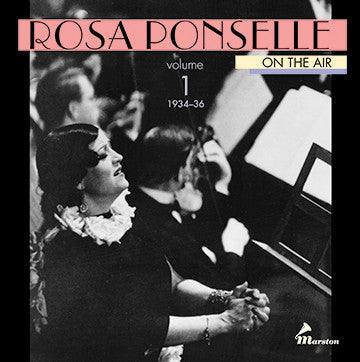

Rosa Ponselle was arguably this century's greatest soprano. Artists such as Callas and Caruso acknowledged her vocal supremacy. Ponselle's voice had volume, beauty, emotion, sure intonation and remarkable flexibility. Before Rosa Ponselle (1897-1981), there had been no leading American singer who had not first made his or her mark abroad. This two-CD set marks the first volume of her on the air recordings. By Ponselle's own account, her broadcasts captured her true voice and she preferred these performances to her numerous commercial recordings. This set chronicles the Chesterfield broadcasts from 1934-1936 which demonstrate Ponselle at her best.
| CD 1 (77:59) | |||
| CHESTERFIELD HOUR | |||
| 1 October 1934 | |||
| 1. | DON GIOVANNI: Batti, batti, o bel Masetto (Mozart) | 4:37 | |
| 2. | I Love You Truly (Bond) | 2:50 | |
| 3. | The Cuckoo Clock (Schaefer) | 1:29 | |
| 4. | Homing (Del Riego) | 3:05 | |
| | |||
| 8 October 1934 | |||
| 5. | Ave Maria (Adapted from Cavalleria Rusticana: "Intermezzo") (Mascagni/Weatherly) | 4:10 | |
| 6. | In Luxembourg Gardens (Lockhart-Manning) | 2:28 | |
| 7. | CARMEN: Chanson bohème (Bizet) | 2:51 | |
| 8. | THE CHOCOLATE SOLDIER: My Hero (O. Straus) | 3:09 | |
| | |||
| 15 October 1934 | |||
| 9. | Blue Danube Waltz (J. Strauss) | 4:41 | |
| 10. | La Golondrina (Serradell) | 4:12 | |
| 11. | Will-o'-the-Wisp (Spross) | 1:27 | |
| 12. | Wiegenlied (Brahms) | 2:51 | |
| | |||
| 29 October 1934 | |||
| 13. | SAMSON ET DALILA: Printemps qui commence (Saint-Saëns) | 6:32 | |
| 14. | La Violetera (Padilla) | 3:19 | |
| 15. | The Last Rose of Summer (Traditional) | 4:10 | |
| | |||
| 19 November 1934 | |||
| 16. | Ave Maria (Sandoval) | 4:44 | |
| 17. | Estrellita (Ponce) | 3:02 | |
| 18. | The Sleigh (Tchervanow-Kountz) | 1:17 | |
| 19. | DIE LUSTIGE WITWE: Waltz Song (Lehár) | 3:13 | |
| | |||
| 26 November 1934 | |||
| 20. | CARMEN: Habanera (Bizet) | 4:18 | |
| 21. | A Dream (Bartlett) | 3:54 | |
| 22. | What's in the Air Today (Eden) | 2:05 | |
| 23. | The Rosary (Nevin) | 3:22 | |
| | |||
| All tracks originally broadcast from New York City All tracks accompanied by orchestra, conducted by André Kostelanetz Languages: Italian [1, 16]; English [2-5, 6, 8-9, 11, 15, 18-19, 21-23]; French [7, 13, 20]; Spanish [10, 14, 17]; and German [12] | |||
| | |||
| CD 2 (67:48) | |||
| | |||
| 3 December 1934 | |||
| 1. | ALCESTE: Divinités du Styx (Gluck) | 4:31 | |
| 2. | Mariä Wiegenlied (Reger) | 2:34 | |
| 3. | The Big Brown Bear (Mana-Zucca) | 2:00 | |
| 4. | Good-bye (Tosti) | 4:56 | |
| | |||
| 26 February 1936 | |||
| 5. | Nur wer die Sehnsucht kennt (Tchaikowsky) | 3:47 | |
| 6. | HERE'S TO ROMANCE: I Carry You in My Pocket (Grosvenor) | 3:21 | |
| 7. | CARMEN: Air des cartes (Bizet) | 4:12 | |
| 8. | CARMEN: Séguedille (Bizet) | 2:20 | |
| | |||
| 4 March 1936 | |||
| 9. | Der Erlkönig (Schubert) | 4:09 | |
| 10. | Danny Boy (Traditional) | 4:19 | |
| 11. | Clavelitos (Valverde) | 1:25 | |
| 12. | CARMEN: Chanson bohème (Bizet) | 3:02 | |
| | |||
| 11 March 1936 | |||
| 13. | CAVALLERIA RUSTICANA: Voi lo sapete (Mascagni) | 3:17 | |
| 14. | The Old Refrain (Kreisler) | 4:13 | |
| 15. | Comin' Thro' the Rye (Traditional) | 2:12 | |
| 16. | L'ultima canzone (Tosti) | 3:56 | |
| | |||
| 18 March 1936 | |||
| 17. | FEDRA: O divina Afrodite (Romani) | 4:31 | |
| 18. | Humoresque (Dvorák) | 4:18 | |
| 19. | When I Have Sung My Songs (Charles) | 2:04 | |
| 20. | Ouvre ton coeur (Bizet) | 2:41 | |
| | |||
| All tracks originally broadcast from New York City All tracks accompanied by orchestra, conducted by André Kostelanetz except Track 3 which is accompanied by piano, Charles Henderson Languages: French [1, 7-8, 12, 20]; German [2, 5, 9]; English [3-4, 6, 10, 14-15, 18-19]; Spanish [11]; and Italian [13, 16-17] | |||
Photographs: Bill Park and The Rosa Ponselle Foundation
Producers: Bill Park and Ward Marston
Audio Conservation: Ward Marston
Booklet Design: Takeshi Takahashi
Marston would like to thank Elayne Duke, Robert Fazio, Lawrence F. Holdridge, Peter Lack and William Shaman for their help in the production of this CD release.
